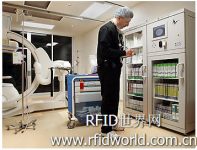
Southern Ohio Medical Center plans to expand RFID asset tracking system
[ad_1]
Like other medical institutions, employees of Southern Ohio Medical Center (SOMC) have to spend a lot of time every week looking for medical equipment such as infusion pumps, on-board electrocardiogram equipment and wheelchairs. In some cases, in addition to walking around to find out, employees also send emails to each other to inquire about specific equipment.
On average, SOMC employees need to search and inspect more than 700 pieces of equipment every month. Greg Malone, director of biomedical engineering, said that most of the devices are relatively easy to find; but 20%-30% of the devices are highly mobile and difficult to locate, which has become a burden on the daily work of hospital staff and has also prompted the hospital to adopt RFID systems for tracking. assets.

Use RFID system to quickly track labeled medical equipment
In October 2007, SOMC adopted the Reveal asset tracking platform developed by Radianse. So far, the hospital has purchased 2500 Radiance 433 MHz active RFID tags and achieved 1,600 assets labeling. Some tags can be directly attached to the device on the back, and some have a short cord that can be tied to the device’s feet.
In order to make the label correspond to the asset labeled, Paul Tessier, the founder and executive vice president of Radianse, said that hospital employees use a handheld barcode scanner to read the barcode printed on the surface of the label. The ID of the barcode is the same as the ID number of the RFID chip. Then, the employee enters the detailed information of the item, such as the type and model, and stores the data in the medical center database. According to Tessier, the label is reusable and contains a replaceable battery. If the tag transmits signals at a rate of once every 10 seconds, the battery life is 2 years; if the tag transmits at a rate of once every 30 seconds, the battery life is 6 years.
A total of 364 receivers are installed throughout the hospital, and the receivers are connected to the SOMC server via Ethernet. The receivers are separated by 30 feet. Its reading distance can reach 50-60 feet, and the positioning accuracy of the device is within 3 feet. When 3 or more receivers receive the ID number of the tag, the Radianse software judges the location of the device based on the strength of the signal. “We require room-level accuracy.” Malone explained.
Hospital staff can use any PC in the hospital to open a Radianse link and enter the password to search for a piece of equipment. They can also build a library of commonly used links based on frequently searched devices.
When the device enters the wrong area, the system can send an alarm according to the setting. For example, if a piece of equipment that cannot be flushed is brought into the flushing room, the employee will receive an alarm. If a certain type of equipment is returned, the hospital staff can quickly find all the equipment that needs to be returned, saving search time.
In August 2007, Radianse completed the installation of the hospital receiver, and SOMC began to label the equipment. The staff received training in September, and the necessary hardware and software were fully installed in the hospital in October.
SOMC now has a total of 220 beds. The hospital is now adding 102 wards and operating rooms. The hospital plans to also install receivers on the new site to track and label assets. In the future, SOMC hopes to expand this system to realize patient tracking and integrate the RFID system with the hospital’s office management system, such as the charging system.
[ad_2]



